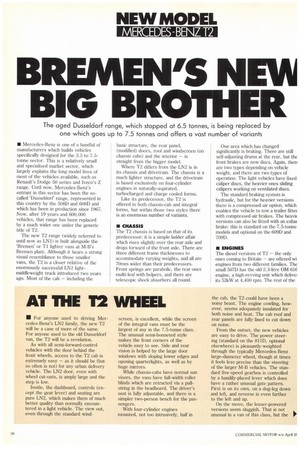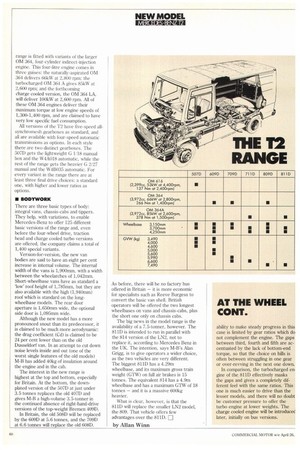BREMEN'S NBIl BIG BROTHER
Page 58

Page 60

If you've noticed an error in this article please click here to report it so we can fix it.
The aged Dusseldorf range, which stopped at 6.5 tonnes, is being replaced by one which goes up to 7.5 tonnes and offers a vast number of variants
• Mercedes-Benz is one of a handful of manufacturers which builds vehicles specifically designed for the 3.5 to 7.5tonne sector. This is a relatively small and specialised market sector, which largely explains the long model lives of most of the vehicles available, such as Renault's Dodge 50 series and Iveco's Z range. Until now, Mercedes-Benz's entrant in this sector has been the socalled 'Dusseldorf' range, represented in this country by the 508D and 608D and which has been in production since 1967. Now, after 19 years and 600,000 vehicles, that range has been replaced by a much wider one under the generic title of 12.
The new '1'2 range (widely referred to until now as LN1) is built alongside the 'Bremen' or Ti lighter vans at M-B's Bremen plant. Although it bears a strong visual resemblance to those smaller vans, the 12 is a closer relative of the enormously successful LN2 lightmiddleweight truck introduced two years ago. Most of the cab — including the basic structure, the rear panel, (modified) doors, roof and windscreen (on chassis cabs) and the interior — is straight from the bigger model.
Where T2 differs from the LN2 is in its chassis and drivetrain. The chassis is a much lighter structure, and the drivetrain is based exclusively on four-cylinder engines in naturally-aspirated, turbocharged and charge cooled forms.
Like its predecessor, the T2 is offered in both chassis-cab and integral forms, but within those two styles there is an enormous number of variants.
• CHASSIS The 12 chassis is based on that of its predecessor: it is a simple ladder affair which rises slightly over the rear axle and drops forward of the front axle. There are three different frame thicknesses to accommodate varying weights, and all are 70mm wider than their predecessors. Front springs are parabolic, the rear ones multi-leaf with helpers, and there are telescopic shock absorbers all round. One area which has changed significantly is braking. There are still self-adjusting drums at the rear, but the front brakes are now discs. Again, then are two types depending on vehicle weight, and there are two types of operation. The light vehicles have fixed. caliper discs, the heavier ones sliding calipers working on ventilated discs.
The standard braking system is hydraulic, but for the heavier versions there is a compressed-air option, which enables the vehicle to tow a trailer fitte( with compressed-air brakes. The heavit versions can also be fitted with an exhat brake: this is standard on the 7.5-tonne models and optional on the 609D and 709D.
• ENGINES The diesel versions of 12 — the only ones coming to Britain — are offered wi engines from two different families. The small 507D has the old 2.3-litre OM 616 engine, a high-revving unit which delivei its 53kW at 4,400 rpm. The rest of the range is fitted with variants of the larger OM 364, four-cylinder indirect-injection engine. This four-litre engine comes in three guises: the naturally-aspirated OM 364 delivers 66kW at 2.800 rpm; the turbocharged OM 364 A gives 85kW at 2,600 rpm: and the forthcoming charge cooled version, the OM 364 LA, will deliver 100kW at 2,600 rpm. All of these OM 364 engines deliver their maximum torque at low engine speeds of 1,300-1,400 rpm, and are claimed to have very low specific fuel consumption.
All versions of the 12 have five-speed allsynchromesh gearboxes as standard, and all are available with four-speed automatic transmissions as options. In each style there are two distinct gearboxes. The 5071) gets the lightweight G 1/18 manual box and the W4A018 automatic, while the rest of the range gets the heavier G 2/27 manual and the W4B035 automatic. For every variant in the range there are at least three final drive choices: a standard one, with higher and lower ratios as options.
II BODYWORK
There are three basic types of body: integral vans, chassis-cabs and tippers. They help, with variations, to enable Mercedes-Benz to offer 125 different basic versions of the range and, even before the four-wheel drive, traction head and charge cooled turbo versions are offered, the company claims a total of 1,400 special variants.
Version-for-version, the new van bodies are said to have an eight per cent increase in internal volume. The internal width of the vans is 1,900mm, with a width between the wheelarches of 1,042mm. Short-wheelbase vans have as standard a 'low' roof height of 1,785nun, but they are also available with the high (1,940nam) roof which is standard on the longwheelbase models. The rear door aperture is 1,650mm wide, the optional side door is 1,095mm wide.
Although the new model has a more pronounced snout than its predecessor, it is claimed to be much more aerodynamic: the drag coefficient (Cd) is claimed to be 24 per cent lower than on the old Dusseldorf van. In an attempt to cut down noise levels inside and out (one of the worst single features of the old models) M-B has added 40kg of insulation around the engine and in the cab.
The interest in the new range is highest at the top and bottom, especially for Britain. At the bottom, the downplated version of the 507D at just under 3.5 tonnes replaces the old 407D and gives M-B a high-volume 3.5-tonner in the continued absence of right-hand-drive versions of the top-weight Bremen 40911 In Britain, the old 5081) will be replaced by the 609D at 5.6 tonnes, and the 7091) at 6.6 tonnes will replace the old 608D. As before, there will be no factory bus offered in Britain — it is more economic for specialists such as Reeve Burgess to convert the basic van shell. British operators will be offered the two longest wheelbases on vans and chassis-cabs, plus the short one only on chassis cabs.
The big news in the model range is the availability of a 7.5-tonner, however. The 811D is intended to run in parallel with the 814 version of the LN2, not to replace it, according to Mercedes Benz in the UK. The intention, says M-B's Alan Grigg, is to give operators a wider choice, as the two vehicles are very different. The biggest 8111) has a 4.29m
wheelbase, and its maximum gross train weight (GTW) on full air brakes is 15 tonnes, The equivalent 814 has a 4.9m wheelbase and has a maximum GTW of 18 tonnes — and it is a massive 600kg heavier.
What is clear, however, is that the 8111) will replace the smaller LN2 model, the 809. That vehicle offers few advantages over the 8111).
































































